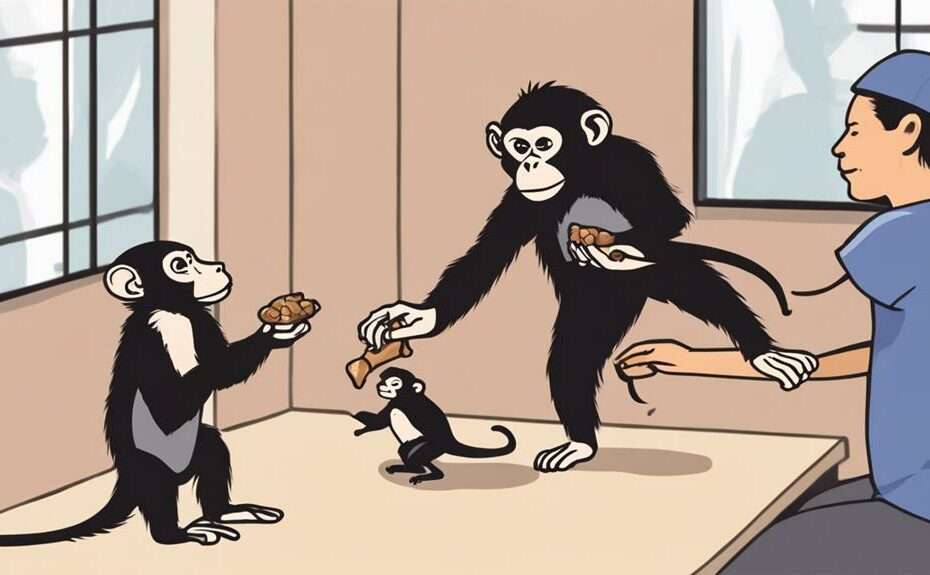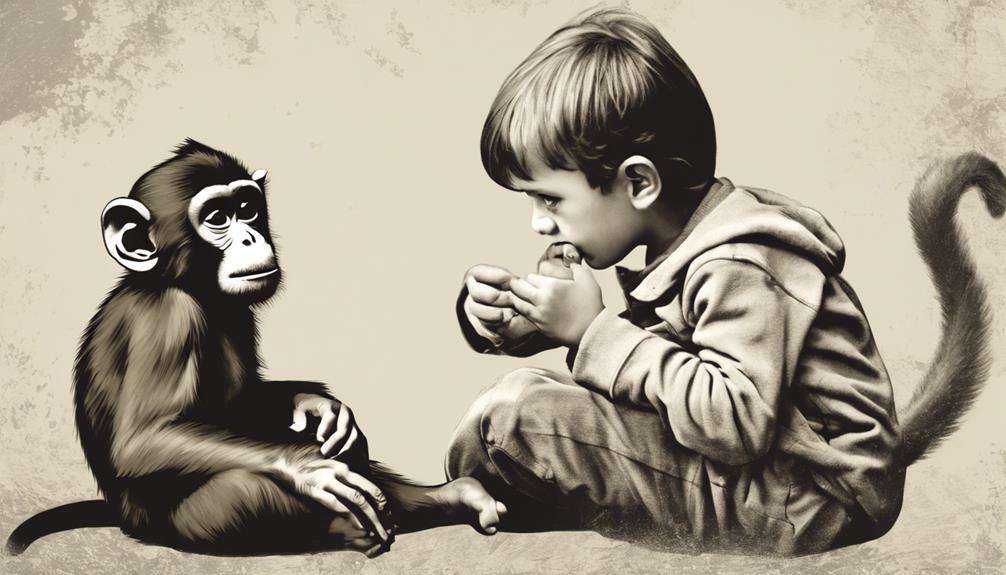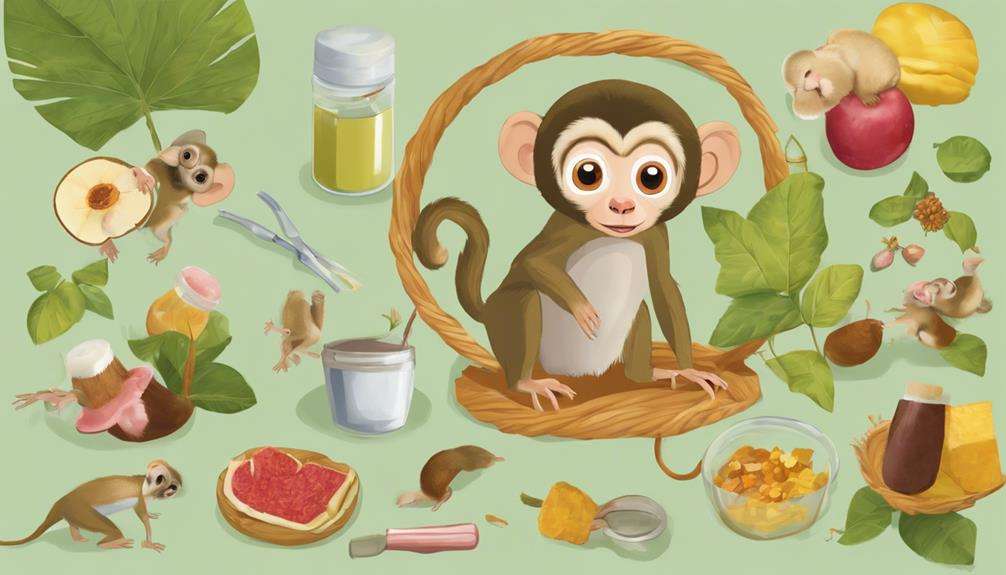You might wonder if training pet capuchins is challenging, but with effective techniques, it can be rewarding. Discover how positive reinforcement, clicker training, and understanding their natural behaviors can lead to successful outcomes.
From basic commands to complex tasks, building a strong bond with your capuchin is essential. Stay tuned to explore various strategies that can help you navigate the training journey with your furry companion.
Key Takeaways
- Use positive reinforcement with high-value treats for effective training.
- Incorporate clicker training to enhance communication and learning.
- Build trust and consistency through structured routines and rewards.
- Provide cognitive enrichment activities to promote mental agility and well-being.
Understanding Capuchin Behavior
Understanding Capuchin behavior involves observing their intricate social dynamics, problem-solving skills, and communication within their natural habitat. Capuchin monkeys, known for their intelligence, live in social groups ranging from 6 to 40 members. Within these groups, they exhibit complex social structures where individuals establish hierarchies through various interactions. Communication plays a important role in maintaining cohesion within the group, with vocalizations, facial expressions, and body language all serving as means of conveying information and emotions.
In their social structure, Capuchins display behaviors that are essential for group living, such as cooperation in foraging and providing protection against predators. These interactions aren't only based on immediate needs but also contribute to the overall well-being of the group. Understanding the intricacies of their social dynamics and communication patterns is important for comprehending their behavior and developing effective training techniques that respect their natural tendencies.
Positive Reinforcement Training Methods
When training your pet capuchin, utilizing treat-based rewards can be highly effective in reinforcing positive behaviors.
Incorporating clicker training techniques can help pinpoint the precise moments when your capuchin exhibits the desired behavior, enhancing communication during training sessions.
Consistency in rewards and cues is essential to fostering understanding and trust between you and your capuchin, leading to successful training outcomes.
Treat-Based Rewards
Utilizing high-value treats such as fruits, nuts, or small insects is integral in reinforcing desired behaviors effectively during positive reinforcement training for pet capuchins. By offering these treats as rewards, you not only motivate your capuchin but also safeguard their welfare during training.
Consistency in delivering treats is vital; it helps your pet associate the behavior with the reward over several months. Immediate reinforcement, where the treat follows the desired behavior promptly, strengthens the learning process.
As your capuchin becomes proficient, gradually reducing the frequency of treats can aid in solidifying learned behaviors. Remember, the goal is to shift from external rewards to internalized behavior, promoting long-lasting results and a strong bond between you and your pet.
Clicker Training Techniques
Incorporating clicker training techniques into your pet capuchin's training regimen can enhance communication and reinforce desired behaviors effectively.
Clicker training, often used in positive reinforcement methods, involves using a clicker to mark the exact moment your capuchin performs a desired behavior, followed by a reward. By consistently pairing the click sound with a treat, your capuchin learns to associate the click with a reward, helping them understand which behaviors lead to positive outcomes.
This method establishes clear communication between you and your pet, strengthening your bond. Clicker training can be particularly useful for teaching complex tricks and behaviors by breaking them down into smaller, manageable steps, allowing you to build upon each success and reinforce the connection between the clicker, behavior, and reward every time they interact with one another.
Clicker Training for Capuchins
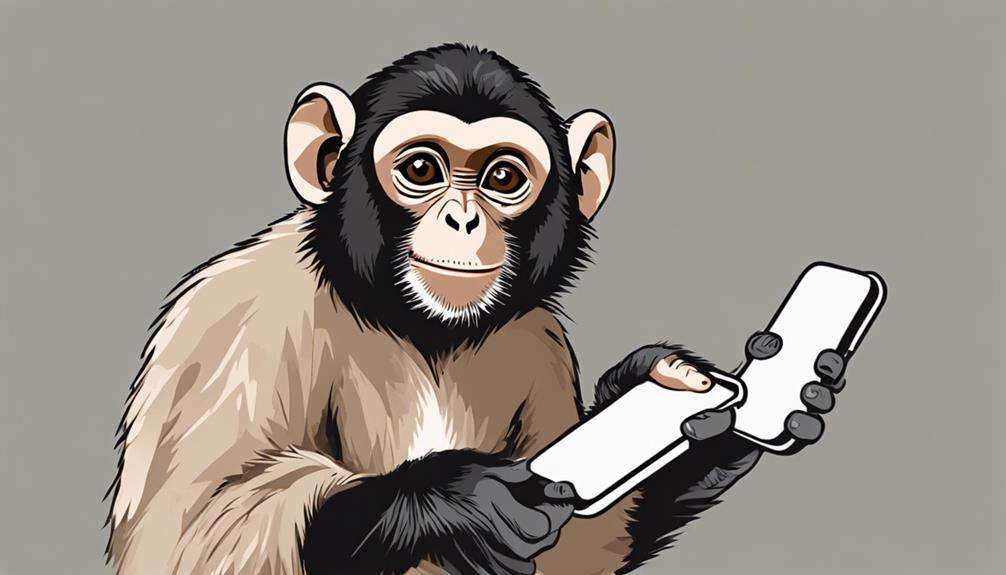
Clicker training for capuchins enhances communication and strengthens the bond between owners and their pet primates by using a clicker to mark desired behaviors and reinforce positive actions. This technique is rooted in behavior modification, offering cognitive stimulation to these intelligent animals while enhancing communication between them and their human companions.
The clicker serves as a bridge between the behavior exhibited by the capuchin and the reward it receives, aiding in their understanding of which actions lead to treats. Importance in timing and the association of the click with a treat are crucial components for successful clicker training with capuchins. Due to their high intelligence and ability to associate the sound of the clicker with rewards, capuchins can quickly grasp new behaviors through this method.
Building Trust and Bonding
Spending quality time with your pet capuchin, using positive reinforcement techniques like treats and praise, can help build trust and strengthen your bond.
By respecting your capuchin's boundaries and allowing them to approach you on their terms, you foster a sense of trust and mutual respect.
Engaging in consistent daily routines and interactive play activities will create a positive and enjoyable experience for both you and your pet capuchin.
Trust Through Positive Reinforcement
To build a strong bond and trust with your pet capuchin, utilize rewards such as favorite treats, toys, or praise to reinforce positive behaviors consistently. Important reinforcement plays a vital role in trust building and behavior understanding.
By rewarding desired actions, you create a positive training environment that strengthens the bond between you and your capuchin. Consistency in using important reinforcement techniques helps your capuchin associate good behavior with pleasant outcomes, fostering a deeper connection.
Establishing Daily Routines
Establishing a consistent daily routine is essential for fostering trust and bonding with your pet capuchin. Daily exercise is vital for their physical health and mental well-being. Incorporate activities like climbing, swinging, and foraging to keep them active and engaged.
Mental stimulation is also critical, so include puzzle toys, food puzzles, and training sessions in their schedule to challenge their cognitive abilities. Playtime bonding is a wonderful way to strengthen your relationship with your capuchin. Spend quality time interacting through grooming sessions, interactive games, or exploring new environments together.
Enrichment Activities for Stimulating Learning

Enrichment activities play an important role in stimulating the learning capabilities of pet capuchins, enhancing both their mental acuity and physical prowess. Introducing food puzzles and foraging games can engage their problem-solving abilities while satisfying their natural instinct to forage.
Sensory enrichment, such as incorporating various scents, sounds, and textures, can further enrich their cognitive development. It's essential to provide rotating toys and interactive devices to prevent boredom, encourage exploration, and boost creativity in capuchin monkeys.
By mimicking natural behaviors like climbing, swinging, and exploring, these activities not only keep capuchins mentally stimulated but also promote physical activity, contributing to their overall well-being. Regularly changing enrichment items helps maintain engagement and prevents habituation, ensuring that the learning process remains dynamic and exciting for your pet capuchin.
Incorporating a variety of enrichment activities tailored to their natural behaviors is key to fostering a stimulating learning environment for pet capuchins.
Problem-Solving Training Techniques
Introducing problem-solving training techniques for your pet capuchin monkeys involves presenting them with puzzles and tasks to figure out, stimulating their cognitive abilities and keeping them mentally engaged. Problem-solving challenges provide mental stimulation essential for your capuchin's well-being.
By incorporating tool usage and object manipulation into their training sessions, you can enhance their problem-solving skills. Gradually increasing the difficulty levels of these tasks can lead to cognitive enhancement in your pet capuchins. Reward-based training plays an important role in reinforcing positive problem-solving behaviors.
Varying the complexity of the challenges helps in continuously challenging and improving the capuchin's problem-solving abilities. Through these techniques, you can create a stimulating environment that promotes mental agility and keeps your pet capuchins engaged and content. By engaging in these activities regularly, you can provide your capuchins with the mental exercise they need to thrive.
Socialization Skills Development
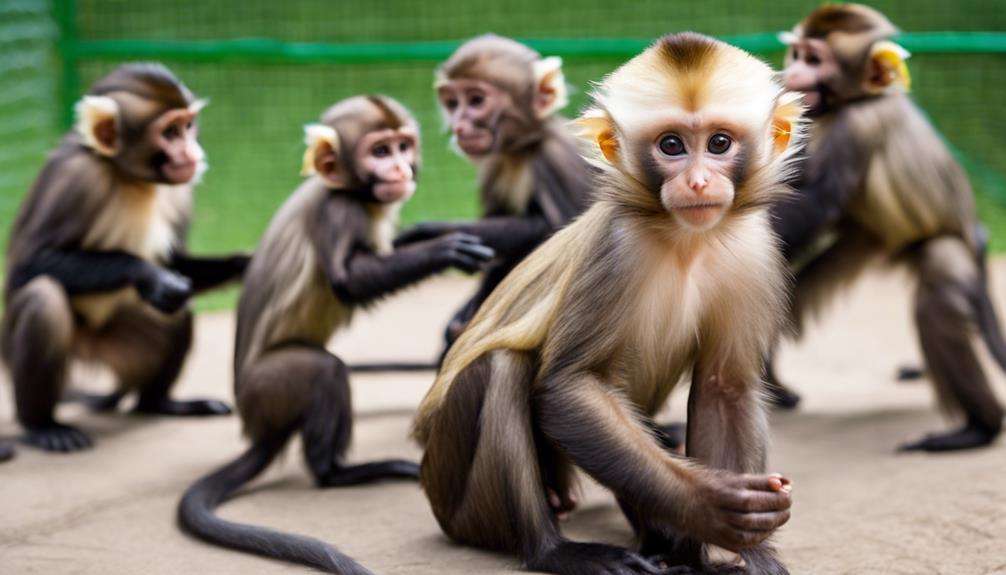
Develop your pet capuchins' socialization skills through consistent interaction with humans and other animals, fostering positive behaviors like sharing, grooming, and playing.
Socialization progress in pet capuchins can be achieved through interactive activities that encourage social bonding and playtime engagement. It's essential to expose your capuchins to various environments and experiences to enrich their surroundings and aid in their social skills development.
Providing opportunities for supervised social interactions with other capuchins can greatly enhance their socialization abilities. Consistent training and reinforcement of desired social behaviors are key to developing well-socialized pet capuchins.
Remember to create a positive and supportive environment that encourages social interaction and reinforces positive social behaviors. By focusing on socialization skills development, you can help your pet capuchins thrive in their interactions with both humans and other animals, leading to happier and more well-adjusted companions.
Addressing Aggression and Undesirable Behaviors
To effectively address aggression and undesirable behaviors in your pet capuchins, utilize positive reinforcement techniques such as rewards and praise to encourage desirable behaviors while discouraging aggression. Behavior modification is key in managing aggression; by consistently rewarding positive actions and redirecting negative behaviors towards more important ones, you can shape your capuchin's conduct effectively.
Implementing a structured training regimen aids in setting clear boundaries and reinforcing good behavior, reducing instances of aggression. Additionally, providing ample mental and physical stimulation through enrichment activities and interactive toys can help prevent boredom-induced aggression.
Seeking guidance from experienced animal behaviorists or trainers is important to address underlying causes of aggression and develop tailored training plans. Regularly track your pet capuchin's behavior patterns to monitor progress, identify potential triggers, and adjust training techniques as needed.
Consistency and Patience in Training
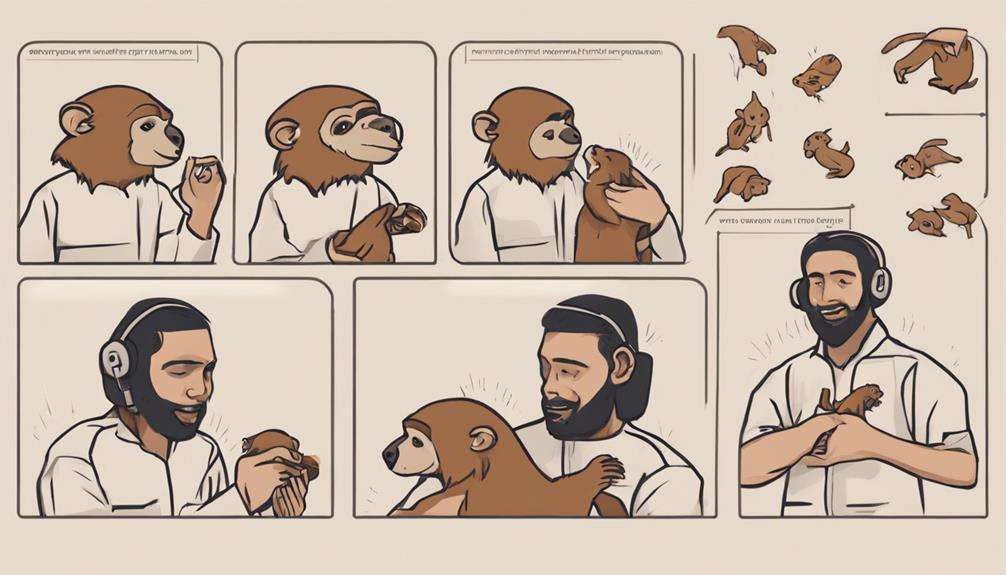
Consistently reinforcing positive behaviors through patient and regular training sessions is essential for effectively teaching pet capuchins new commands and behaviors. Training consistency is vital as it helps these intelligent animals learn and remember commands more efficiently. Patience plays a significant role in training pet capuchins, as they may require time to understand and respond to instructions. By establishing a routine with clear, simple commands, you can enhance the learning process for your pet capuchin. Utilizing reward-based techniques is also key, as it can motivate them to participate and acquire new behaviors.
In addition, incorporating positive reinforcement during training sessions can help strengthen the bond between you and your pet capuchin while reinforcing good behavior. This approach not only encourages desired actions but also fosters a trusting relationship. Remember, patience and consistency are fundamental when working with pet capuchins, ensuring a positive and effective training experience for both you and your furry companion.
Frequently Asked Questions
How Do Capuchin Monkeys Learn?
You learn by observing and imitating others in your social group. You excel at problem solving and innovation, using tools and unique foraging strategies. Social learning is key to your growth, fostering imitation, skill development, and adaptive behaviors.
Are Capuchin Monkeys Trainable?
Capuchin monkeys are trainable due to their intelligence and ability to learn complex behaviors. Positive reinforcement and patience are essential for behavior modification. Tailor training to their personality for effective results. Seek guidance for best training techniques.
Why Are the Capuchin Monkey Selected for Training?
In the fascinating dance of training capuchins, their intelligence levels and adaptability shine. Their social behavior and communication prowess, combined with problem-solving acumen and tool use, make them prime candidates for learning and companionship.
How Do You Tame a Capuchin Monkey?
To tame a capuchin monkey, start by building trust through patience training. Use socialization techniques like offering treats and gentle touch. Respect boundaries and avoid sudden movements. Seek guidance from experts for effective taming methods.
Conclusion
To sum up, effective training techniques for pet capuchins involve:
- Understanding their behavior
- Using positive reinforcement methods
- Building a strong bond based on trust
While some may argue that training a pet capuchin is challenging, with consistency and patience, you can overcome any obstacles and create a rewarding and enriching experience for both you and your furry companion.
Remember, the key to successful training is understanding and respecting the unique personality of your pet capuchin.
